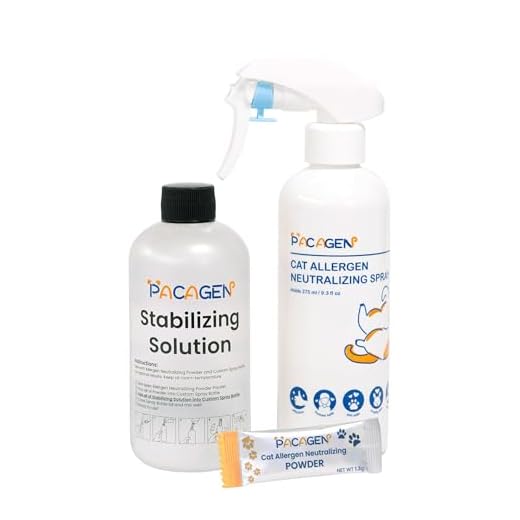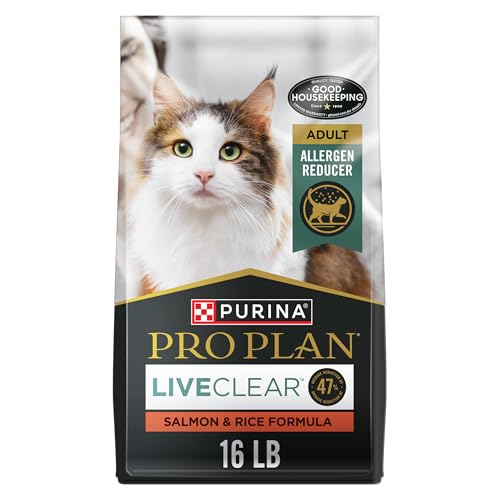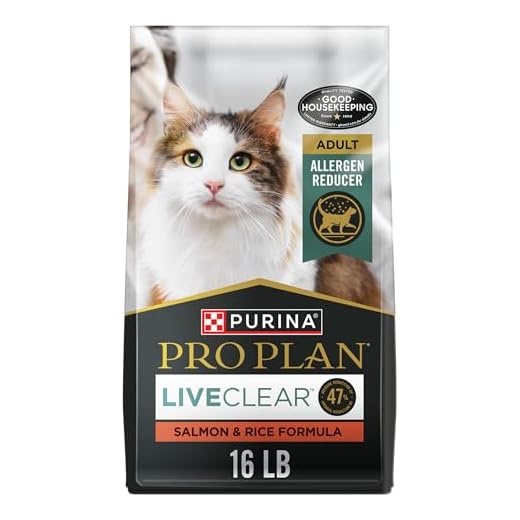



Identifying the cause is key. Regularly monitor food, environment, and grooming products. If sneezing, itching, or gastrointestinal upset occurs, it’s time to act.
Switch to hypoallergenic food. A limited ingredient diet may help isolate triggers. Consult with a veterinarian for recommendations tailored to individual needs.
Environmental factors matter too. Regularly clean the living space, reducing dust and pollen. Consider air purifiers to improve air quality. Keep an eye on seasonal changes that might introduce new irritants.
Grooming plays a significant role in management. Regular brushing reduces dander and hair shedding. Use gentle shampoos designed for sensitive skin, and consult with a vet for appropriate bathing schedules.
Observation is crucial. Keep a journal of symptoms and potential triggers. This data can aid your veterinary professional in tailoring effective treatment plans.
Medication may be necessary. Antihistamines or corticosteroids can alleviate symptoms but should only be administered under a vet’s guidance.
Finally, consider allergy testing. This can pinpoint specific sensitivities and guide long-term management strategies. A proactive approach ensures comfort and health.
Identifying Symptoms of Allergies in Cats
Watch for excessive scratching or biting at the skin. Redness and inflammation may appear, indicating irritation. Keep an eye on the ears, as frequent shaking or scratching could signal issues.
Observe for watery eyes or sneezing. Clear discharge often suggests environmental triggers. A runny nose may also accompany these symptoms, especially during seasonal changes.
Look for changes in grooming habits. If a feline stops grooming or displays unkempt fur, it might indicate discomfort. Notice if there’s an increase in shedding or the presence of bald patches.
Monitor appetite and behavior. A sudden drop in food intake or lethargy can point to underlying health issues. Pay attention to any unusual vocalizations or signs of distress.
Check for gastrointestinal symptoms like vomiting or diarrhea. These can be linked to food sensitivities, affecting overall well-being. Maintain a record of any patterns related to diet.
Keep track of how these signs develop over time. Documenting symptoms can assist in discussions with a veterinarian, helping pinpoint specific allergens and necessary adjustments.
Steps to Reduce Allergen Exposure for Your Cat
Regularly clean living spaces with a vacuum equipped with a HEPA filter to trap dust, pollen, and other irritants effectively.
Consider using air purifiers in common areas to enhance air quality and minimize airborne allergens.
Wash bedding, blankets, and toys weekly in hot water to eliminate potential allergens and maintain a clean environment.
Implement a strict no-shoes policy indoors to reduce the introduction of outdoor allergens.
Opt for hypoallergenic cat food if food sensitivities are suspected; consult a vet for appropriate dietary changes.
Keep windows closed during high pollen seasons and use air conditioning to regulate indoor temperatures.
Regularly groom fur to limit dander and allergens in the home; brushing should occur at least once a week.
Limit access to areas with carpets and heavy drapes that can trap allergens; consider replacing these with hard flooring and washable curtains.
Introduce indoor plants known for their air-purifying qualities, ensuring they are non-toxic.
Monitor and minimize stress levels, as heightened anxiety can exacerbate reactions to allergens; create a calming environment with safe spaces and enrichment activities.
When to Consult a Veterinarian for Allergy Treatment
If persistent symptoms like itching, excessive grooming, or skin infections occur, it’s time to seek professional help. A vet can conduct specific tests to identify triggers and recommend appropriate treatments.
Signs such as difficulty breathing, swelling, or severe vomiting indicate an immediate need for veterinary attention. These reactions could signal a serious condition requiring urgent care.
Regular check-ups are beneficial, especially if symptoms worsen despite reducing allergen exposure. A veterinarian can provide tailored advice and may suggest dietary changes or medications.
In cases where weight loss is noted without changes in eating habits, consider exploring resources about why is my cat so skinny even though she eats. It’s crucial to address any underlying health issues in conjunction with allergy management.
FAQ:
What are the common signs that my cat might have allergies?
Common signs of allergies in cats include excessive scratching, licking, or biting at the skin, which may lead to hair loss or skin infections. You might also notice symptoms like sneezing, coughing, watery eyes, or nasal discharge. Some cats may develop gastrointestinal issues, such as vomiting or diarrhea. If you observe any of these signs persisting, it’s advisable to consult a veterinarian for a proper diagnosis and treatment plan.
How can I help my cat if I suspect it has allergies?
If you suspect your cat has allergies, the first step is to observe its behavior and symptoms closely. Take note of any changes in its environment, diet, or routine that could be contributing factors. Consider consulting a veterinarian who can perform tests to identify specific allergens. Depending on the diagnosis, treatment options may include dietary changes, antihistamines, or topical treatments to alleviate symptoms. Additionally, regular grooming and cleaning your home can help reduce exposure to allergens like dust or pollen. Staying vigilant about your cat’s health and making necessary adjustments can significantly improve its quality of life.
Identifying the cause is key. Regularly monitor food, environment, and grooming products. If sneezing, itching, or gastrointestinal upset occurs, it’s time to act.
Switch to hypoallergenic food. A limited ingredient diet may help isolate triggers. Consult with a veterinarian for recommendations tailored to individual needs.
Environmental factors matter too. Regularly clean the living space, reducing dust and pollen. Consider air purifiers to improve air quality. Keep an eye on seasonal changes that might introduce new irritants.
Grooming plays a significant role in management. Regular brushing reduces dander and hair shedding. Use gentle shampoos designed for sensitive skin, and consult with a vet for appropriate bathing schedules.
Observation is crucial. Keep a journal of symptoms and potential triggers. This data can aid your veterinary professional in tailoring effective treatment plans.
Medication may be necessary. Antihistamines or corticosteroids can alleviate symptoms but should only be administered under a vet’s guidance.
Finally, consider allergy testing. This can pinpoint specific sensitivities and guide long-term management strategies. A proactive approach ensures comfort and health.
Identifying Symptoms of Allergies in Cats
Watch for excessive scratching or biting at the skin. Redness and inflammation may appear, indicating irritation. Keep an eye on the ears, as frequent shaking or scratching could signal issues.
Observe for watery eyes or sneezing. Clear discharge often suggests environmental triggers. A runny nose may also accompany these symptoms, especially during seasonal changes.
Look for changes in grooming habits. If a feline stops grooming or displays unkempt fur, it might indicate discomfort. Notice if there’s an increase in shedding or the presence of bald patches.
Monitor appetite and behavior. A sudden drop in food intake or lethargy can point to underlying health issues. Pay attention to any unusual vocalizations or signs of distress.
Check for gastrointestinal symptoms like vomiting or diarrhea. These can be linked to food sensitivities, affecting overall well-being. Maintain a record of any patterns related to diet.
Keep track of how these signs develop over time. Documenting symptoms can assist in discussions with a veterinarian, helping pinpoint specific allergens and necessary adjustments.
Steps to Reduce Allergen Exposure for Your Cat
Regularly clean living spaces with a vacuum equipped with a HEPA filter to trap dust, pollen, and other irritants effectively.
Consider using air purifiers in common areas to enhance air quality and minimize airborne allergens.
Wash bedding, blankets, and toys weekly in hot water to eliminate potential allergens and maintain a clean environment.
Implement a strict no-shoes policy indoors to reduce the introduction of outdoor allergens.
Opt for hypoallergenic cat food if food sensitivities are suspected; consult a vet for appropriate dietary changes.
Keep windows closed during high pollen seasons and use air conditioning to regulate indoor temperatures.
Regularly groom fur to limit dander and allergens in the home; brushing should occur at least once a week.
Limit access to areas with carpets and heavy drapes that can trap allergens; consider replacing these with hard flooring and washable curtains.
Introduce indoor plants known for their air-purifying qualities, ensuring they are non-toxic.
Monitor and minimize stress levels, as heightened anxiety can exacerbate reactions to allergens; create a calming environment with safe spaces and enrichment activities.
When to Consult a Veterinarian for Allergy Treatment
If persistent symptoms like itching, excessive grooming, or skin infections occur, it’s time to seek professional help. A vet can conduct specific tests to identify triggers and recommend appropriate treatments.
Signs such as difficulty breathing, swelling, or severe vomiting indicate an immediate need for veterinary attention. These reactions could signal a serious condition requiring urgent care.
Regular check-ups are beneficial, especially if symptoms worsen despite reducing allergen exposure. A veterinarian can provide tailored advice and may suggest dietary changes or medications.
In cases where weight loss is noted without changes in eating habits, consider exploring resources about why is my cat so skinny even though she eats. It’s crucial to address any underlying health issues in conjunction with allergy management.
FAQ:
What are the common signs that my cat might have allergies?
Common signs of allergies in cats include excessive scratching, licking, or biting at the skin, which may lead to hair loss or skin infections. You might also notice symptoms like sneezing, coughing, watery eyes, or nasal discharge. Some cats may develop gastrointestinal issues, such as vomiting or diarrhea. If you observe any of these signs persisting, it’s advisable to consult a veterinarian for a proper diagnosis and treatment plan.
How can I help my cat if I suspect it has allergies?
If you suspect your cat has allergies, the first step is to observe its behavior and symptoms closely. Take note of any changes in its environment, diet, or routine that could be contributing factors. Consider consulting a veterinarian who can perform tests to identify specific allergens. Depending on the diagnosis, treatment options may include dietary changes, antihistamines, or topical treatments to alleviate symptoms. Additionally, regular grooming and cleaning your home can help reduce exposure to allergens like dust or pollen. Staying vigilant about your cat’s health and making necessary adjustments can significantly improve its quality of life.
Identifying the cause is key. Regularly monitor food, environment, and grooming products. If sneezing, itching, or gastrointestinal upset occurs, it’s time to act.
Switch to hypoallergenic food. A limited ingredient diet may help isolate triggers. Consult with a veterinarian for recommendations tailored to individual needs.
Environmental factors matter too. Regularly clean the living space, reducing dust and pollen. Consider air purifiers to improve air quality. Keep an eye on seasonal changes that might introduce new irritants.
Grooming plays a significant role in management. Regular brushing reduces dander and hair shedding. Use gentle shampoos designed for sensitive skin, and consult with a vet for appropriate bathing schedules.
Observation is crucial. Keep a journal of symptoms and potential triggers. This data can aid your veterinary professional in tailoring effective treatment plans.
Medication may be necessary. Antihistamines or corticosteroids can alleviate symptoms but should only be administered under a vet’s guidance.
Finally, consider allergy testing. This can pinpoint specific sensitivities and guide long-term management strategies. A proactive approach ensures comfort and health.
Identifying Symptoms of Allergies in Cats
Watch for excessive scratching or biting at the skin. Redness and inflammation may appear, indicating irritation. Keep an eye on the ears, as frequent shaking or scratching could signal issues.
Observe for watery eyes or sneezing. Clear discharge often suggests environmental triggers. A runny nose may also accompany these symptoms, especially during seasonal changes.
Look for changes in grooming habits. If a feline stops grooming or displays unkempt fur, it might indicate discomfort. Notice if there’s an increase in shedding or the presence of bald patches.
Monitor appetite and behavior. A sudden drop in food intake or lethargy can point to underlying health issues. Pay attention to any unusual vocalizations or signs of distress.
Check for gastrointestinal symptoms like vomiting or diarrhea. These can be linked to food sensitivities, affecting overall well-being. Maintain a record of any patterns related to diet.
Keep track of how these signs develop over time. Documenting symptoms can assist in discussions with a veterinarian, helping pinpoint specific allergens and necessary adjustments.
Steps to Reduce Allergen Exposure for Your Cat
Regularly clean living spaces with a vacuum equipped with a HEPA filter to trap dust, pollen, and other irritants effectively.
Consider using air purifiers in common areas to enhance air quality and minimize airborne allergens.
Wash bedding, blankets, and toys weekly in hot water to eliminate potential allergens and maintain a clean environment.
Implement a strict no-shoes policy indoors to reduce the introduction of outdoor allergens.
Opt for hypoallergenic cat food if food sensitivities are suspected; consult a vet for appropriate dietary changes.
Keep windows closed during high pollen seasons and use air conditioning to regulate indoor temperatures.
Regularly groom fur to limit dander and allergens in the home; brushing should occur at least once a week.
Limit access to areas with carpets and heavy drapes that can trap allergens; consider replacing these with hard flooring and washable curtains.
Introduce indoor plants known for their air-purifying qualities, ensuring they are non-toxic.
Monitor and minimize stress levels, as heightened anxiety can exacerbate reactions to allergens; create a calming environment with safe spaces and enrichment activities.
When to Consult a Veterinarian for Allergy Treatment
If persistent symptoms like itching, excessive grooming, or skin infections occur, it’s time to seek professional help. A vet can conduct specific tests to identify triggers and recommend appropriate treatments.
Signs such as difficulty breathing, swelling, or severe vomiting indicate an immediate need for veterinary attention. These reactions could signal a serious condition requiring urgent care.
Regular check-ups are beneficial, especially if symptoms worsen despite reducing allergen exposure. A veterinarian can provide tailored advice and may suggest dietary changes or medications.
In cases where weight loss is noted without changes in eating habits, consider exploring resources about why is my cat so skinny even though she eats. It’s crucial to address any underlying health issues in conjunction with allergy management.
FAQ:
What are the common signs that my cat might have allergies?
Common signs of allergies in cats include excessive scratching, licking, or biting at the skin, which may lead to hair loss or skin infections. You might also notice symptoms like sneezing, coughing, watery eyes, or nasal discharge. Some cats may develop gastrointestinal issues, such as vomiting or diarrhea. If you observe any of these signs persisting, it’s advisable to consult a veterinarian for a proper diagnosis and treatment plan.
How can I help my cat if I suspect it has allergies?
If you suspect your cat has allergies, the first step is to observe its behavior and symptoms closely. Take note of any changes in its environment, diet, or routine that could be contributing factors. Consider consulting a veterinarian who can perform tests to identify specific allergens. Depending on the diagnosis, treatment options may include dietary changes, antihistamines, or topical treatments to alleviate symptoms. Additionally, regular grooming and cleaning your home can help reduce exposure to allergens like dust or pollen. Staying vigilant about your cat’s health and making necessary adjustments can significantly improve its quality of life.









